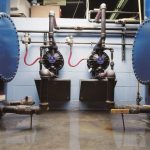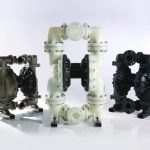One of the main rules of the food industry is compliance with hygiene standards required by regulatory bodies. Incorrect handling can cause food contamination, negatively impacting the company's positioning in the market, and causing considerable financial losses.
However, keeping its operation within the necessary standards requires the company to make investments, without impacting its profitability. It is important to find the balance between productivity, efficiency and waste reduction to ensure the company's success. For this reason, pneumatic diaphragm pumps are a strategic and cost-effective option for companies looking to handle food products safely and reliably. That's because this type of bomb:
· Transports different types of liquid, with a wide range of viscosities;
· Can perform transfer, loading and unloading functions;
· Handle fluids over a wide temperature range;
· Transport fluids with hygiene;
· They are easy to clean;
· Meet the specifications of Organs responsible bodies.
Because they are so versatile, pneumatic diaphragm pumps are widely used in the food and beverage industry.
What are the advantages of the pneumatic diaphragm pump?
In addition to the aspects mentioned above, pneumatic pumps have several advantages for the handling beverages and food products, as:
· Are sensitive to shear, with smooth pumping;
· Can handle solids without causing damage to the pump structure;
· They are self-priming and do not require positive inlet pressure to operate;
· Can run dry;
· They are easy to clean;
· Can be grounded for safety;
· They are portable;
· They have a low initial purchase price.
What types of pumps are used in the food industry?
In this sector, there are two types of pneumatic diaphragm pumps that can be used:
FDA-Compliant Pumps: In the United States, the FDA certifies equipment that must be manufactured from FDA-approved materials.
3-A Hygienic Pump: This type of pump must be manufactured in accordance with 3-A standards and the certification undergoes an annual review.
Although they are very similar, these pumps have different applications, as we will see below:
FDA pumps are often used when handling juices, citrus oils, wines, beers, sauces, condiments, etc. In the case of 3-A hygienic pumps, they are more commonly applied in the dairy industry. In general, this type of pump is manufactured so that it can be dismantled and received the on-site cleaning, in order to prevent residues from being trapped and developing bacteria and other microorganisms. Click here and see this Saniforce series pump, which is FDA certified.
The main differences between these two pumps are:
FDA pumps: have a high polish finish (150 microinches); need to be disassembled for cleaning and they need to be turned over manually for drainage.
Hygienic pumps: they have a polished finish (32 microinches); have rotating pump bracket for drainage and are third-party certified.
Before choosing a pump for use in the food industry, it is important to pay attention to the certification levels required by regulatory bodies, what products will be pumped, how cleaning will be done and what budget is available. Providing safety and durability, pneumatic diaphragm pumps do not always have to be sanitary. For transporting sanitizing chemicals, for example, standard pumps can be used.










